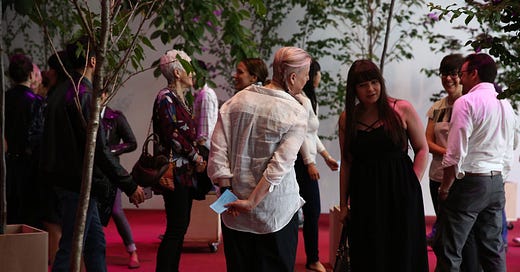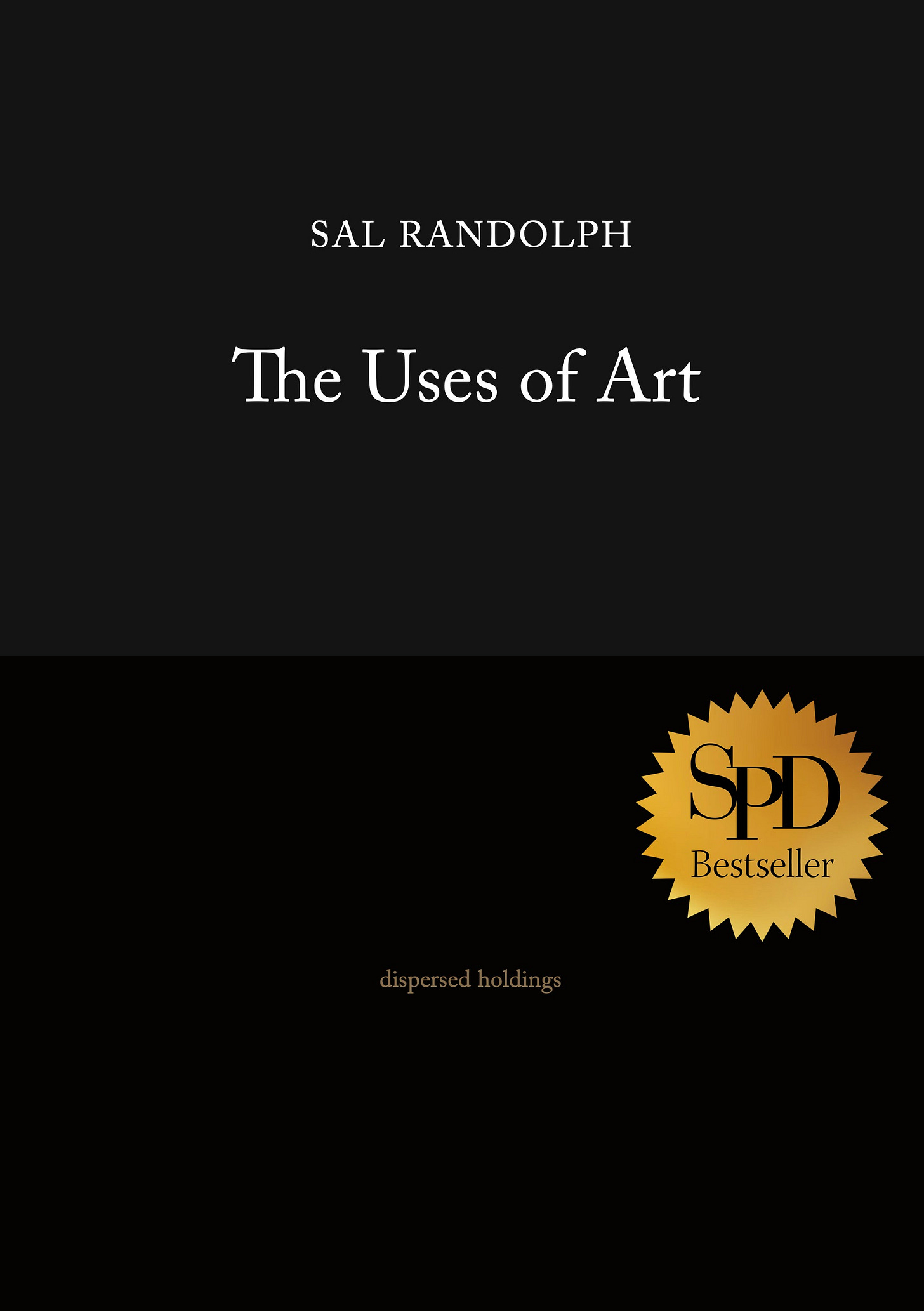
Dear Friends,
I’m thrilled to say that I have five poems now up in Pamenar, a press dedicated to hybrid, multilingual, and experimental forms of poetry.
These poems are part of a sequence I wrote in the throes of a multi-year obsession with sonnets.
How did this happen to me? Read on!
— Sal

An Invitation to be a Sonnet
Back in 2017, my dear friend Jeff Dolven was organizing an event for the Whitney Museum called 14 Person Poem. Jeff described it as “a collective experiment in sharing a poem in physical and social space.” It was to take place inside an installation by Asad Raza called Root Sequence. Mother Tongue.
His idea was that visitors to the installation would encounter a person, a performer, who would intimately offer a single line from a poem. Person to person, almost a whisper in the ear.
All the poems were sonnets, poems of fourteen lines. To hear every line, you would have to circulate and find each of the fourteen performers but you still wouldn’t know which line was meant to follow another. The language was encountered first in fragments, in a kind of dispersed state.
However, if you waited a little while, you would hear a bell. All the performers, all of us, would would gather in a circle and recite the poem’s lines in order so that the whole poem was revealed, first very slowly, and then at a speaking pace. Finally, the group turned to face the center of the circle and spoke all the lines at once, collapsing the poem into sound.
Jeff asked eight poets to write sonnets for the occasion: Maureen McLane, Geoffrey Nutter, Rowan Ricardo Phillips, Tracy K. Smith, Mónica de la Torre, Dorothea von Moltke, Monica Youn, and myself. Several more joined us as performers. Each poem unfolded over fifteen minutes.
As you can imagine, I was both flattered and wildly inspired. Once I had written a sonnet for Jeff, I couldn’t stop writing them. I studied the sonnets of Shakespeare, Wyatt, and Donne, the morphing sonnets of Rilke, and the wilder contemporary sonnets of Bernadette Mayer and Ted Berrigan.
I adapted the form into one with my own rules, extending a studio practice I called “language drawing,” and spent years writing long, experimental sonnet-sequences. I started with sonnets that bounced off pop songs and then continued through the strange, urgent times of the pandemic lockdowns. I kept going, insatiable.
The poems below are some of the results.
Two Sonnets
XI Sea birds cross salty go crying rises wind as we one by one meanwhile go ward by eyes seeing couldn’t let justice below all fear beyond memorial time still talking to dream into shadow only meeting alone do into but saw looking today needed anyway anything prove too many never let through waiting wouldn’t dream a whole in would exactly crossing to steam saw rapid out of place rapid to ready walk breathless in night letting go by will not walk to mercy to the river breathing sense catch waving being caught the river leading water. XII Hold dreaming to night crowded could if close part to prove part with leaving positions here without wherever all gravity keeping without how am that already stay both hands close to touch use myself to tell have come forgiveness dazzle in need while somewhere else found when tired my maybe taking my good don’t what holding lost me strength hidden make here by summer walking about where never done together be just rather carry won’t like mind that know would in tell me with style likely like that frightened on any were content to hold until faded me to fact would know myself.
Find all five at Pamenar.

Jeff Dolven on 14 Person Poem
It happens like this: you enter the bright room on the west side of the sixth floor of the Whitney Museum of American Art. You are among young trees, twenty-six of them, growing from wooden boxes raised on casters, spaced out around the room; the floor is red carpet, the light a mix of sun from the windows and a magenta glow from the bulbs on the ceiling. You may have a moment to look around, or you may be approached right away by someone who says: Find a furrow in your sleep. Or, The ridge. A ladder asleep against a house. Or, That went, This was our planet, a past tense. Then the speaker moves right on, and someone else catches you by the elbow: all night in when down when joy down oh when. Or, Given the recent turn of events, it might have resisted blooming. You might start to seek these people out, to gather more lines, but before long a chime sounds and the readers, who have been circulating freely, form a circle in the center of the room. You count fourteen, if you count. Facing outward, they recite a poem—that’s what the fourteen lines add up to, now they are in order, though each is still in a different voice, moving slowly around the circle. Then the circle of fourteen turns inward, and there is the poem again, this time read faster, as though the lines were the utterance of a single speaker. Then one more time, all at once, the lines on top of one another; and then the circle dissolves. A reader approaches you again, with a new line from a new poem.
…
Poetry readings are ordinarily a hierarchical affair, with someone in the front of the room reading, everybody else listening, nobody moving too much. The arrangement serves the art well, but bringing poems into the social space of “Root Sequence. Mother Tongue” seemed to call for something different. The choreography of the 14 Person Poem activates potentials that ordinary readings tend to neglect: combinatorial poetics, à la Raymond Queneau, reorganizing a poem on the fly; the pathos of the fragment, the poem scattered like a Sappho lyric, recovered only in pieces; the private circulation of samizdat; and perhaps the peculiar, up-close intimacy of the ancient mariner, with something unforgettable to share with you, only you, and now. On that particular Sunday, watching the room from outside was like watching a text diffusing through a culture in real time. Many of us who participated wondered afterward where else such a distributed, communal reading might work: on a subway platform, in a park, on the street? The single line is a hook, a way for the poem to get across and to get to you before you know it is a poem. What about other lengths, shorter or longer than the day’s sonnets and pseudo-sonnets? Poems more site-specific, or less? Would there be ways of turning listeners into readers, even on the spot? There is room for more experiment, and poetry asks experiment.
Read more of Jeff’s story along with the poems in BOMB.
About Jeff Dolven.
I’d love to hear from you!
Further adventures and new ways of seeing can be found in my book, The Uses of Art.
Artist Sal Randolph’s THE USES OF ART is a memoir of transformative encounters with works of art, inviting readers into new methods of looking that are both liberating and emboldening.
Dazzlingly original, ferociously intelligent.
— Michael Cunningham
A joyful, dazzling treasure-box of a book.
— Bonnie Friedman
Here’s a guide, to waking up, over and over again.
— Roshi Pat Enkyo O’Hara





